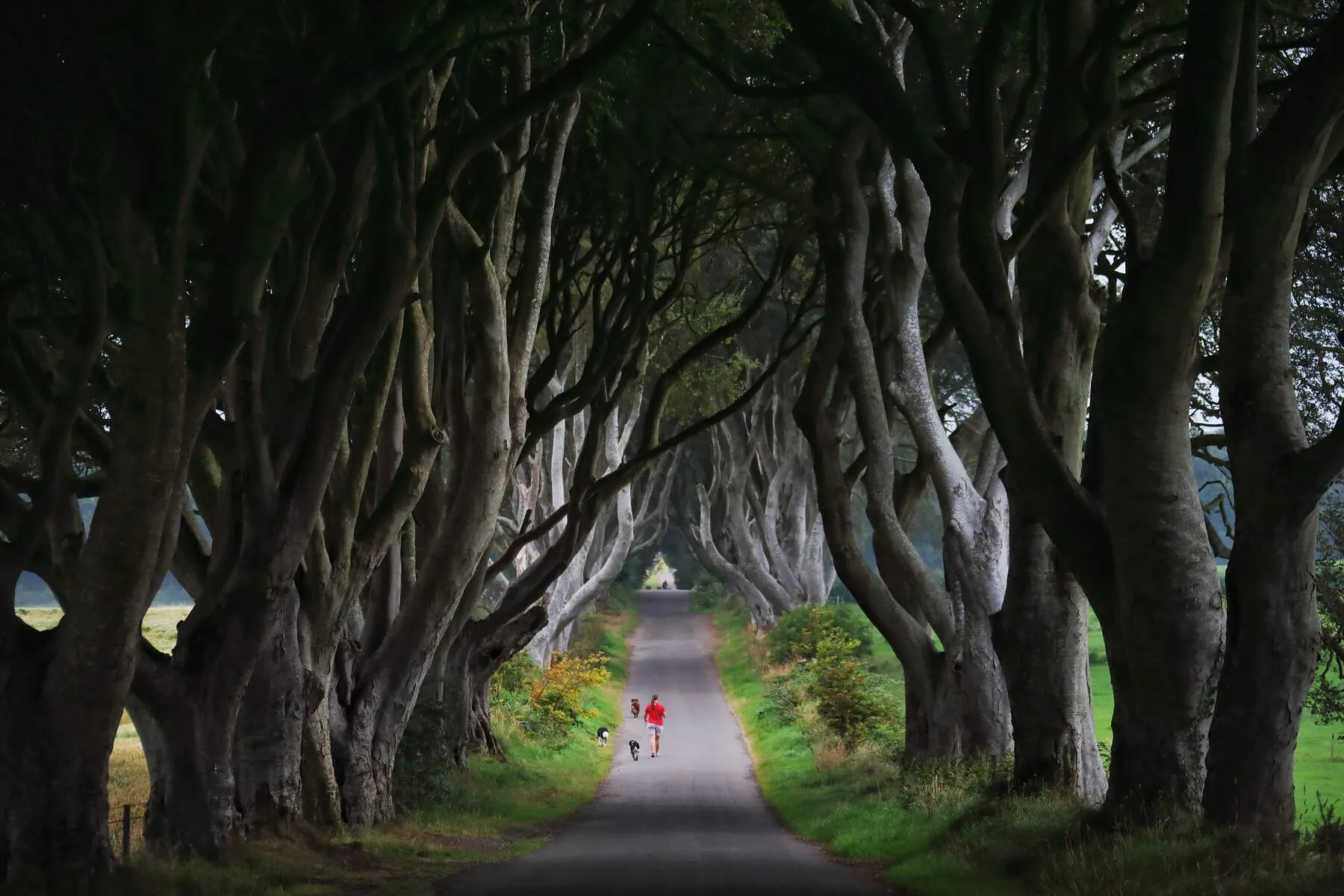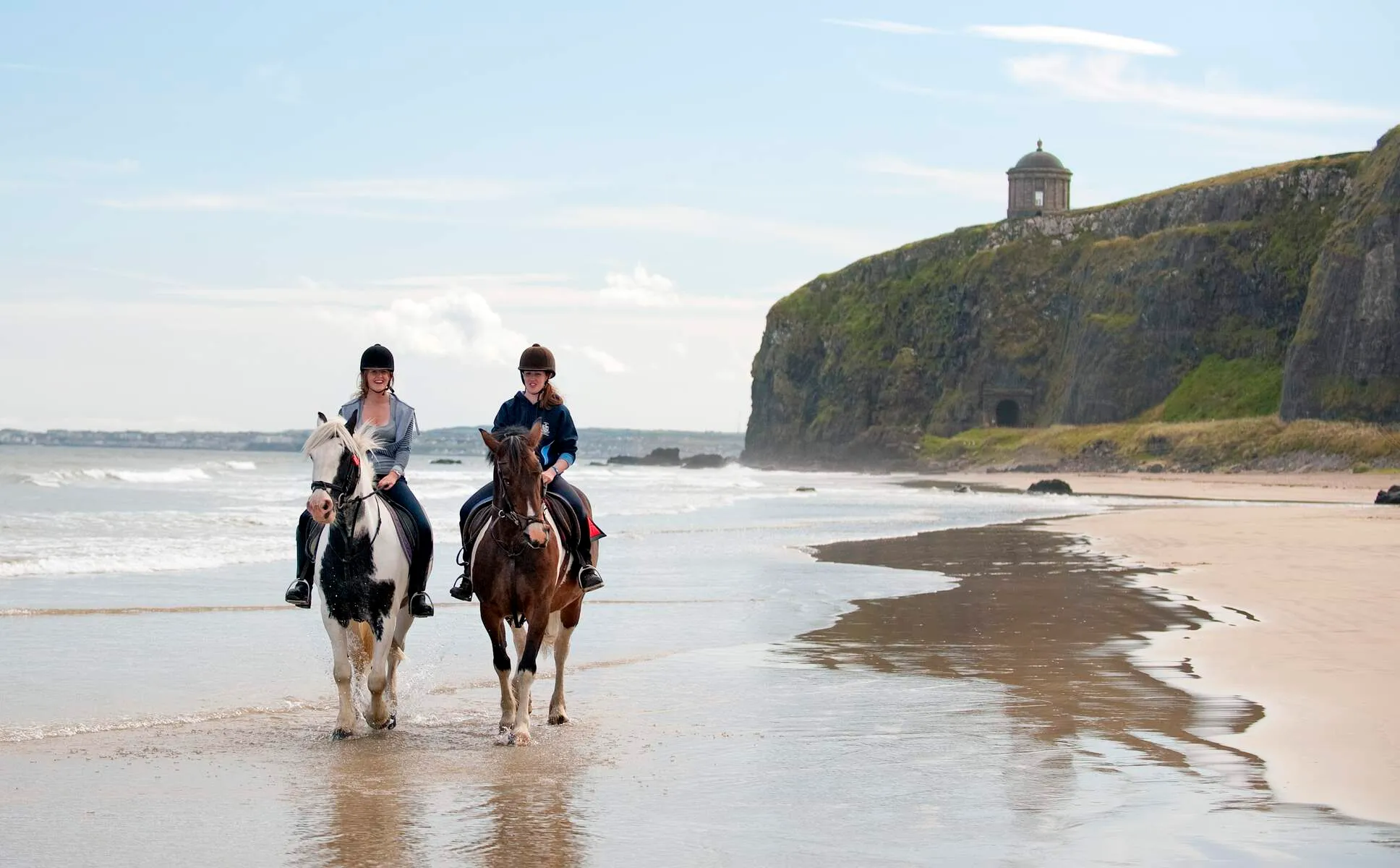Dunluce Castle, perched dramatically on a basalt outcrop along Northern Ireland's rugged Causeway Coast, is a testament to centuries of conflict, ambition, and legend. Its jagged cliffs plunge 100 feet into the Atlantic Ocean, framing a ruin that has witnessed the rise and fall of powerful clans. Originally established in the 13th century by the Norman noble Richard É"g de Burgh, the site's strategic position made it a prize for successive rulers. By the 16th century, the McQuillan clan fortified the castle with imposing drum towers, only to lose it to the MacDonnells-a clan whose leader, Sorley Boy MacDonnell, famously retook the fortress in 1584 after being ousted by English forces. The MacDonnells transformed Dunluce into a symbol of their power, installing cannons salvaged from the 1588 wreck of the Spanish Armada's Girona and constructing a grand manor house for Catherine Manners, Duchess of Buckingham, in the 1630s. Yet the castle's fortunes waned after the Battle of the Boyne (1690), when the MacDonnells' decline led to abandonment and eventual decay.
The castle's haunting beauty is underscored by folklore and historical quirks. Legend claims the kitchen collapsed into the sea during a storm in 1639, an event later disproven by archaeology, though the tale persists. A more somber local myth surrounds Maeve Roe, daughter of a McQuillan lord, who is said to have drowned fleeing the castle with her lover, now a spectral presence. Beyond these stories, Dunluce's physical remnants reveal layers of history: the original McQuillan towers, the MacDonnell-era gatehouse, and the remains of the "lost town" of Dunluce. Established in 1608 by Randal MacDonnell, the town's cobbled streets and innovative indoor toilets-a rarity at the time-were uncovered in 21st-century excavations, offering glimpses of a planned settlement destroyed during the 1641 uprising. Today, visitors wander among these ruins, gazing at the Atlantic horizon and the distant Scottish coast, while exhibitions and guided tours bring the past to life.
Visiting Dunluce offers an immersive journey through time. The castle's precarious perch demands respect for its dangers-uneven terrain and sheer drops necessitate caution-but rewards with panoramic views. Best explored in summer, when longer days allow ample time to absorb its atmosphere, the site also appeals in quieter winter months for solitude. While the kitchen's supposed collapse is a myth, the ruin's crumbling grandeur and the echo of its turbulent history create an unforgettable experience. Whether tracing the outline of the vanished town or imagining the clatter of Spanish cannons, Dunluce remains a place where the past lingers, as palpable as the salt-tinged wind. Its cinematic allure, showcased in Game of Thrones as the seat of House Greyjoy, has only deepened its mystique, cementing it as a cornerstone of Northern Ireland's cultural and natural heritage.
Getting There
Nearest Airports & Train Stations
The closest major airport is Dublin Airport (155 miles/250 km south), with Belfast International (40 miles/64 km southeast) and Belfast City Airport (35 miles/56 km southeast) also serving as options. For rail travel, take the Enterprise train from Dublin Connolly Station to Belfast Lanyon Place (2 hours), then transfer to the Portrush line from Belfast Central Station (1.5 hours to Portrush). From Portrush station, buses or taxis connect to the castle.
Driving Directions
- From Belfast/Dublin: Follow the A26 north toward Ballymoney. At the Portrush Road Roundabout, take the B62 (Ballybogey Road) toward Portrush. Continue onto the A2/Causeway Coastal Route; the castle is 12 miles (20 km) east of Portrush.
- From Derry/Londonderry: Head south on the A6 to Coleraine, then follow the A2 toward Portrush for 37 miles (60 km).
- From Giant's Causeway: It's a short 12-minute drive west along the A2.
Public Transportation
- Buses: The Translink 402 service links Portrush, Ballycastle, and Bushmills, stopping at Dunluce Castle (check schedules at journeyplanner.translink.co.uk). The 172 bus also runs from Portrush's Dunluce Avenue.
- Causeway Rambler: This scenic bus route connects key coastal attractions, including Dunluce Castle.
Organized Tours
Day tours from Dublin and Belfast are available via operators like City Tours Belfast, Paddywagon Tours, and the Giant's Causeway Tour. These typically include Dunluce Castle as a stop, often combining it with the Giant's Causeway or Game of Thrones filming locations.
Local Transportation
The castle is a 6-mile (9.5 km) walk from Portrush, following the A2 and coastal paths past East Strand Beach and Royal Portrush Golf Club. A sidewalk along Dunluce Road makes this route feasible for determined travelers.
Parking
Dunluce Car Park, located a short 5-10 minute walk from the castle entrance. This lot offers disabled access**, but the path to the castle is steep and uneven in parts, so sturdy footwear is advisable.
If Dunluce Car Park is full, Magheracross Car Park serves as an alternative, requiring a 10-minute walk along a scenic route to the castle. Both parking areas are free of charge, and no fees are explicitly tied to parking (though entry to the castle itself requires a paid ticket).
During busy periods, consider arriving early or using public transport options like bus tours (e.g., Belfast City Tours, Giant's Causeway Tour) which stop near the site. Street parking is not available, and there are no on-site parking facilities at the castle itself. Always check signage for any temporary restrictions, though no time limits are noted in the sources. For wheelchair access, ensure you park at Dunluce Car Park, as Magheracross may not have the same facilities.
Pricing
Admission fees to Dunluce Castle are structured as follows:
- Adults: £6.00 (~€7.10).
- Children (5-17 years): £4.00 (~€4.76). Under-5s enter free.
- Concessions: £4.50 (~€5.36) for seniors (65+), students (with ID), disabled visitors, and unemployed citizens.
Family & Group Rates:
- Family Ticket: Up to five people (including up to three adults) for £18.00 (~€21.40).
- Groups:
- £4.50 (~€5.36) per person for groups of 15+ adults, with one free guide included.
- Smaller groups (10+ people) may qualify for £4.00 (~€4.76) per person (advance booking required).
Annual Passes: Available for repeat visitors (purchased on-site only):
- Adult: £12.00 (~€14.28).
- Child (5-17): £8.00 (~€9.52).
- Concession: £9.00 (~€10.70).
- Family: £36.00 (~€42.86).
Free Access: The lower area of the castle grounds is free to explore, though entry to the main castle requires payment.
Additional Costs:
- Guided tours are available for advance booking but pricing is not specified; inquire on-site.
- Specialized access to privately owned land adjacent to the castle (e.g., for photography or elopements) requires a fee from £350 (~€416.50) onward, arranged separately with the landowner.
Payment & Booking:
- Tickets are purchased only at the castle's on-site ticket office; no online booking is available.
- Major credit/debit cards and cash are accepted.
Prices are current as of March 2024 and subject to change. Check opening times before visiting, as they vary seasonally.
Nearby Attractions

Bushmills Distillery
In the village of Bushmills on Northern Ireland's rugged north coast sits the Old Bushmills Distillery. It's famous for being the world's oldest licensed whiskey distillery, getting its permit from Ki...
Distance: 5.8 km

Dark Hedges
Along Bregagh Road in County Antrim, Northern Ireland, lies the Dark Hedges – an avenue of beech trees famous for the dramatic, spooky tunnel formed by their interlocking branches. Planted back in the...
Distance: 16.7 km

Benone Strand
Benone Strand, a seven-mile expanse of golden sand along Northern Ireland's Causeway Coast, is a standout natural wonder distinguished by its clean, firm shores and uninterrupted vistas. A recipient o...
Distance: 17.3 km
